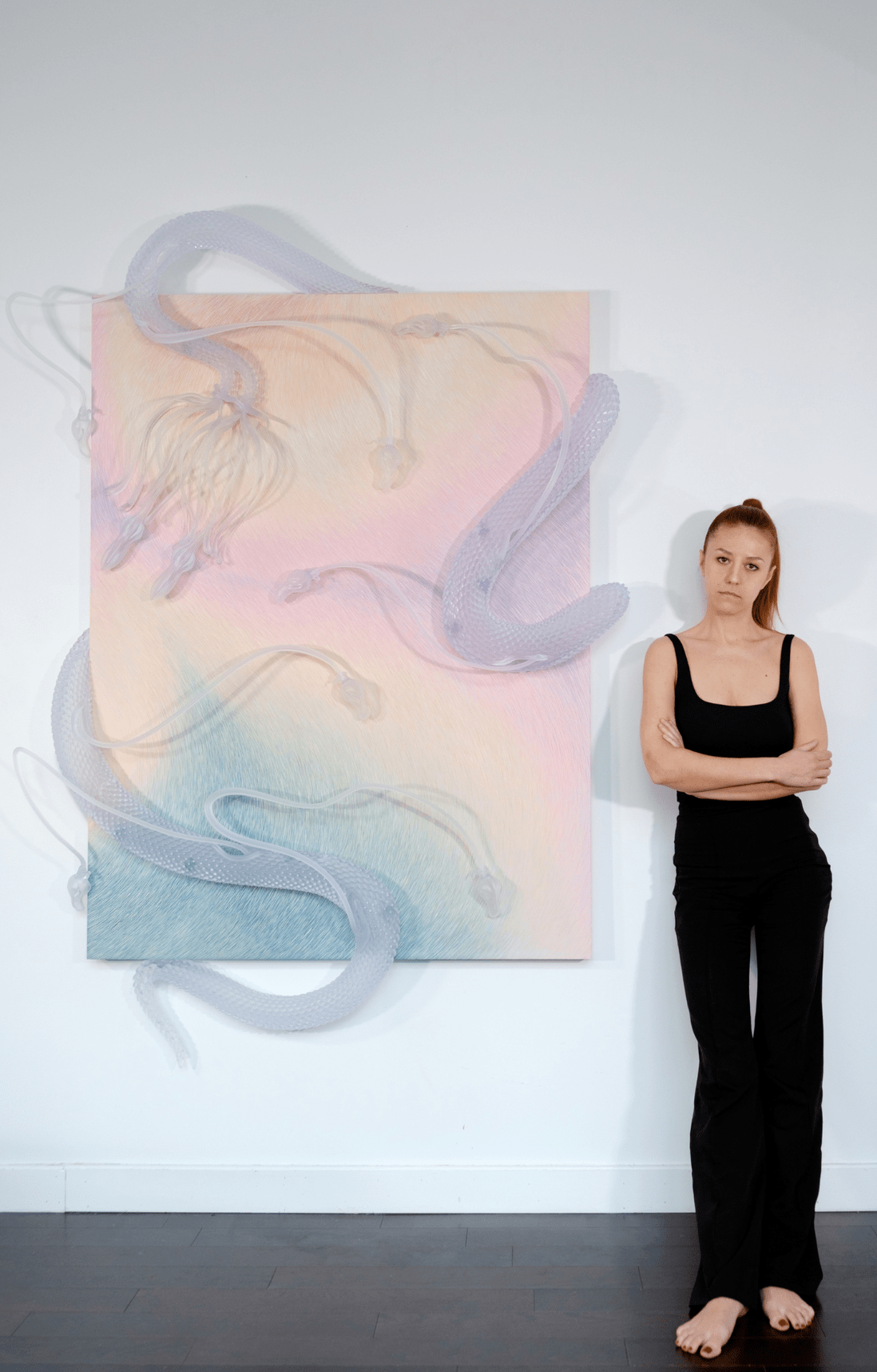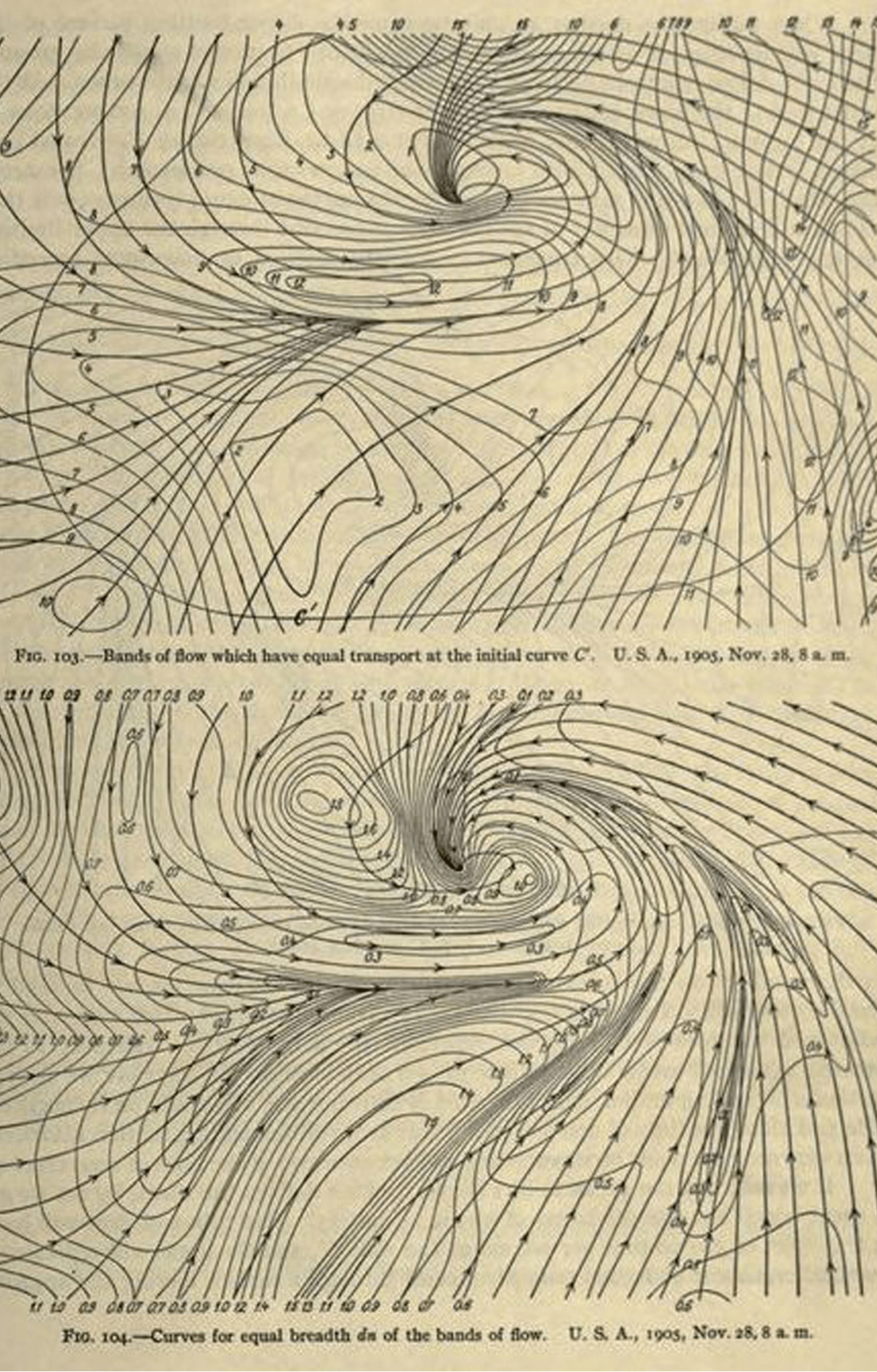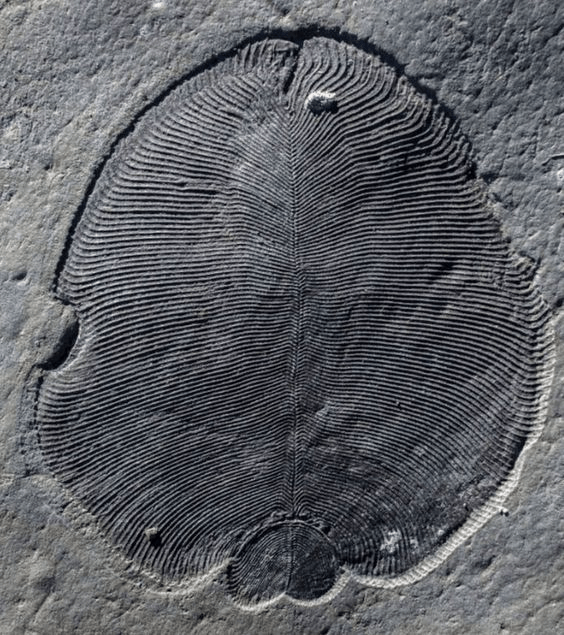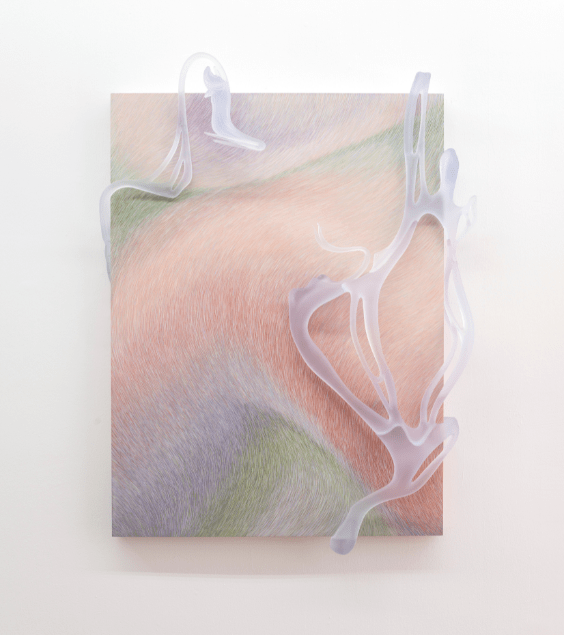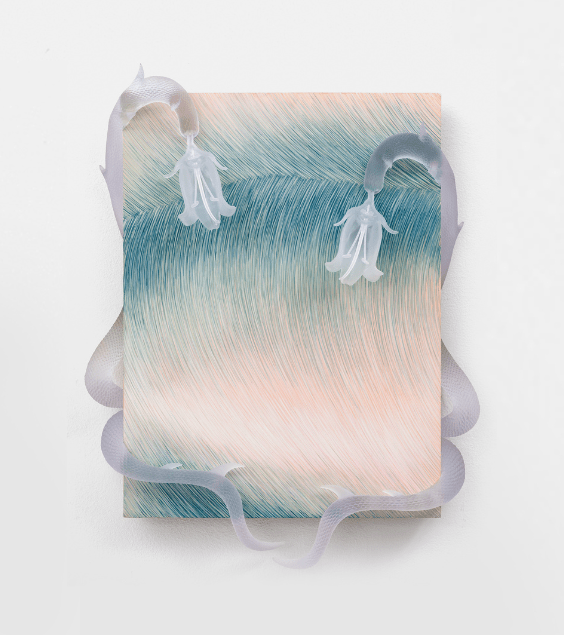
Where things happen #18— October 2023
There are several artists today exploring alternative models of future coexistence between species, working across different media and integrating their practice with some of the latest scientific research, as well as pioneering speculative scenarios of alternative relations between the human and non-human.
Very few, however, are yet able to inglobate this often complex data and previsions in a logical, tangible form such as the traditional canvas, providing with immediacy a strong visual metaphor of this interconnection of elements and creatures, and the new potential configurations this can assume in a hybrid evolution of systems.
New York-based artist Anastasia Komar seems to have reached a form of art able to translate an idea of interdependence, interconnectedness, and fluidity between entities, which relies on the most recent advancements in the fields of both biology and technology: focusing on the restless movements of particles and molecules. In her work, Komar suggests parallels between biological intelligence and the functioning of today’s AI technologies and its generative intelligence in the digital space.
In recent years bio-technology has become in fact a new medium for artists, as technologies and new media previously did, resulting most often in a grotesque marriage between biology and technology.
Following this line of artistic approach, Komar positions her practice at an interesting intersection between developmental biology, artificial intelligence, bioengineering, synthetic morphology, and cognitive science.
I met Anastasia on one of the last days of New York summer at her studio in the Financial District.
I had come across her work at Frieze Seoul, and I was immediately captured by the mystery of intricate forms hauntingly synthesizing and worming around delicate pastel canvases.
Her works appear as something already beyond our current reality, a sort of prophecy of posterity, where relations between the Anthropocene and nature, between bio and technè, will be potentially positively subverted.
These creations strangely appeared both post-human and hi-tech, while intriguingly preserving some poetry in the whirling movements of the industrially made fragments of creatures, and the choice of the hand-painted colors on the surfaces.
When I stepped into Komar’s space, I heard a background noise, someone talking with an academic tone. As she welcomes me in her workspace, I see on the computer screen that a video of an older man discussing scientific images on the side: a conference by Michael Levin, an American developmental and synthetic biologist at Tufts University, whose department is focusing on studying the diverse intelligence in evolved, designed, and hybrid complex systems.
On the wall surrounding the screen, a mysterious but revelatory moodboard combines biological images with some archeological ruins and Bacon’s fragmented bodies: this seems to me a quite a clear visual research field indicating someone who is investigating deeply the meaning of today’s bodies in an ever-evolving existential, psychological and societal environment.
Similarly, her canvases present a fluid flow of marks and filaments which dance around the surface, mimicking the movement of particles under the microscopic lenses.
As she comments: nothing is really stable, matter is in continuous movement and evolution, it just depends on the tools you have to observe the nature of things around you.
At the same time, phantom presences of parasites or parts of mythological creatures made of glass polymer seem to hug or haunt the abstract fields of the luminescent abstract canvas’s surface.
Her work clearly exists at the edge of something, between aesthetic playfulness, the seduction of mystery and the creepiness of the monster.
In this sense, her art also seems to be a great physical metaphor of Derrida’s concept of monstrosity, intended as a subsequent chapter of greater hybridity and fluidity.
First Komar designs them digitally, creating a render that combines elements from different biological illustrations into new hybrid forms, that the then artist shares with remote producers who materialize them.
As she comments over our conversation, it took a while to find the right collaborators, but the scientificity and efficiency of their productions perfectly meet her needs of something hyper-refined, hyper-technological, and hyper-artificial.
As she confirms, these manufacturers are able to interpret with extreme perfection her instructions, both in terms of shapes she wants to create and in terms of the polymer combinations she strives to explore.
The research on materials is very important for the artist, as she’s animated by this restless curiosity to explore the possibility of molecules to combine and turn into new physical systems.
Chemicals and aesthetics are a combination that have inadvertently allowed the work to proceed further both in her aesthetic and conceptual research, but now there are also new interactions that artist feels need to be explored: Komar’s further interest is to intersect these investigations with a study of the possibilities of generative intelligence, and the way these are potentially able to generate entire new biological or non-biological systems, following an auto generative process of self-assembling similar to the ones operated in cells in the living organisms.
In this sense, Komar’s work literally appears to embody an alternative morphogenesis that combines high-tech, handmade, and nature under the belief that there can be a harmony between all of these attributes.
I learn how she only started this current body of work with the pandemic, when also the microscopic level of life suddenly became much more popular and visible. However, just after a year or so, these works are characterized with a great awareness both in the process and in the concepts behind.
After listening to Komar speak about the process, I’m not surprised to learn that she actually studied Architecture in Moscow, within a disciplinary framework that connected it with Urbanism and Ecology in order to contemplate the presence of buildings as part of broader environments and more complex systems.
Komar then shows me some of her early works, which feature these intricate grids that simulate a world potentially designed and visualized with pixels on Autocad, or such.
This really allowed me to understand what she is after in her practice, trying to investigate deeply more sustainable models of relations between different beings and the constructed physical and digital infrastructures that now inglobate, channel and house us.
Going deeper in her research, one can contemplate how Komar’s practice also turns into an interesting attempt to understand and envision how diverse non-human intelligence and evolved hybrid complex systems are, exploring general principles of life-as-it-can-be, and potentially will be.
The composition of her painting surfaces themselves also reflect an interest in the dynamic field of bioelectricity, which studies the ways in which all cells connect in somatic electrical networks that store, process, and act on information to control large-scale body structure in terms of homeostasis and electrophysiology.
Interrogating the possibilities of non-neural cognition and the new possible formations of collective intelligence, in the works Komar is already testing and visualizing new possibilities of coexistence and evolution between human and non-human, nature and Anthropocene, under the belief of a more cosmic order and intelligence that connects systems in regular repetition of forms and mechanisms.
After all, this this approach can also partially reconnect also with the American Transcendentalism, later explored also in art around the 60’s, which invoked a spiritually heightened abstraction and envisioned another word, synthesizing the natural and artificial, and organizing nature and the man-made world into a new order.
Similarly, Komar’s visionary works seem to have already fully realized and embraced the new opportunities of both imagining and building these future scenarios allowed today by the further scientific and anthropological advancements, combined with the biological evolutions caused by a continuous adaptation to an ever-changing ecosystem.























